Samsung Galaxy S WiFi 4.2 Review
Samsung Galaxy S WiFi 4.2
A 4.2in Android iPod touch rival. Samsung Galaxy S3 on the cheap?
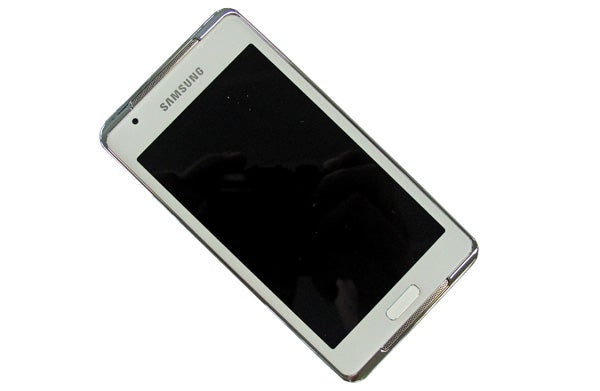
Verdict
Pros
- Excellent video codec support
- Excellent audio codec support
- Decent internal speakers
Cons
- So-so screen
- Could do with dual-core CPU
- Similarly-specced phones at same price
Key Specifications
- Review Price: £179.99
- 4.2in IPS 480 x 800 pixel screen
- 8GB internal memory
- Android 2.3 Gingerbread OS
- 2MP main camera, user-facing VGA camera
- TouchWiz UI
- 1GHz OMAP processor
Devices like the Samsung Galaxy S WiFi 4.2 are now a rarity. It’s a smartphone without the phone bit, making it a media and music player, with games jammed in for good luck. It’s an Android take on the iPod touch, and while it doesn’t entirely make sense any more, it’s a lot of fun.
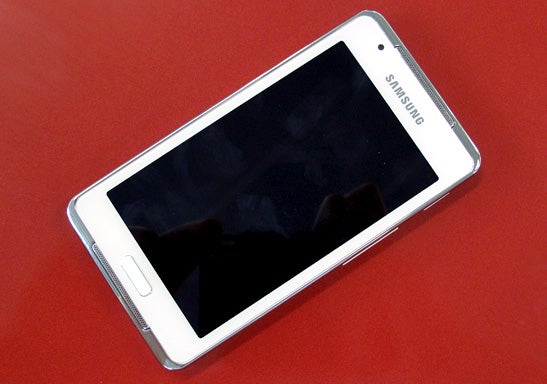
Design
This is the second-generation of Samsung’s non-smartphone Galaxy S slabs. The first had a 5in screen, but this one drops back closer to the mainstream with a 4.2in display.
It’s something of a half-way house between the Samsung Galaxy S2 and the new Galaxy S3. More rectangular than the S3, but with a smaller select button than the S2, you can bet ninety-seven per cent of onlookers will assume you’re palming a new Samsung smartphone.
Also consistent with Samsung’s smartphone design, there’s a whole lot of glossy plastic going on here. Its back is mostly covered by a thin plastic battery cover, and the silver strip that runs around its edges is also plastic. This helps to keep the phone trim, at a light 118g, but doesn’t give the device a super high-end feel – although the same is true of the much-more-expensive Samsung Galaxy S3.
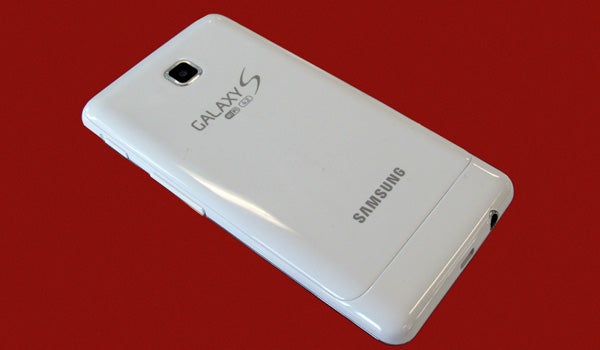
There is no such compromise with the screen covering, though. It is glass, where many budget media players use hard plastic, which scratches more easily and doesn’t feel quite as nice.
The Samsung Galaxy S WiFi 4.2 is a mite thicker than the iPod touch, but this isn’t necessarily a bad thing. As a device of media and gaming, the extra screen space and having a bit more body to grip onto is a big plus. Held horizontally – a likely scenario when gaming or watching video – it feels great between your fingers, with just enough bezel to let your thumbs rest without obstructing the screen.
Connections and speakers
Just a pair of connections sit on the Samsung Galaxy S WiFi 4.2’s body. These live down on the bottom edge – a microUSB to charge the device and give access to its internal memory and the obligatory 3.5mm headphone jack. 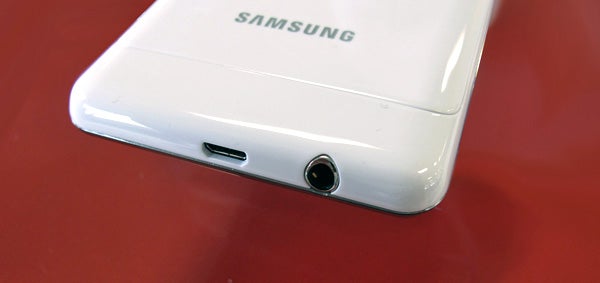
Remove the thin plastic battery cover and you’ll find the microSD memory cad slot. The Galaxy would be sunk without it, because there’s only 8GB of internal memory – around half of which is taken up by pre-installed software and the OS. 8GB may be enough for a phone, but for a music and video player, it just doesn’t cut it. Cards up to 32GB are compatible, which are available for under £20. 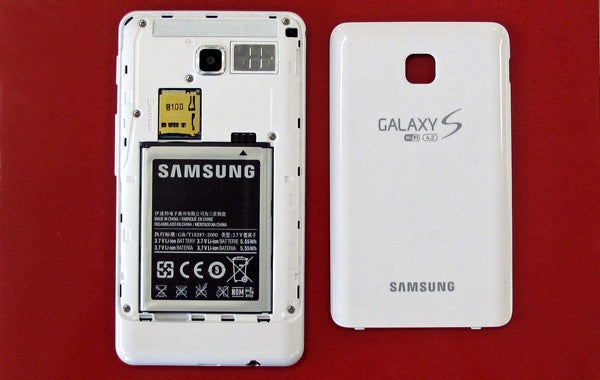
One way the Samsung Galaxy S WiFi 4.2 trumps most smartphones is its use of stereo speakers. Dinky silver grills at the top and bottom of the player hide a pair of speakers, which give you a genuine stereo image if you hold the device fairly close to your face. 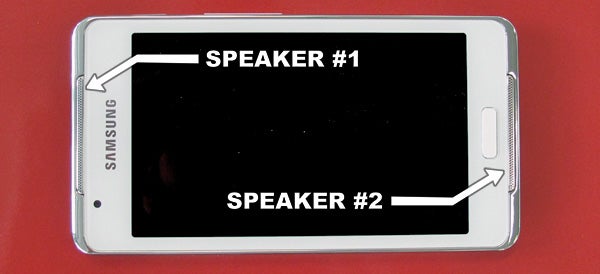
Maximum volume is higher than the smarpthone average too, although there is some slight distortion at top volume and – predictably – sound quality is pretty lo-fi and bass non-existent.
Screen
The Samsung Galaxy S WiFi 4.2 has – as its title suggests – a 4.2in screen. A good compromise between size and ultimate portability, it makes the iPod touch feel dinky and yet still fits comfortably into pockets. It can be argued that a media-centric device like this needs as big a screen as possible, but we’d feel happier carrying this around every day than its 5in brother. 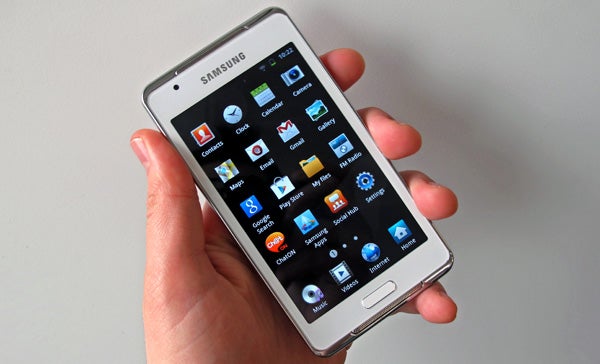
Screen quality is middling by top-end smartphone standards. The Galaxy S WiFi 4.2 uses an IPS TFT screen with 480 x 800 pixel resolution, where phones this size now sport up to 720 x 1280 pixels. However, text is not noticeably blocky unless you look close – where the pixel structure is pretty obvious with the naked eye.
Colour reproduction isn’t hugely impressive, looking a little lifeless next to more expensive devices, but isn’t too much worse than the iPod touch, itself not a patch on the iPhone 4S. Viewing angles are much improved over the previous model, letting people crowd around the screen to watch a movie. Would you want to though? Probably not.
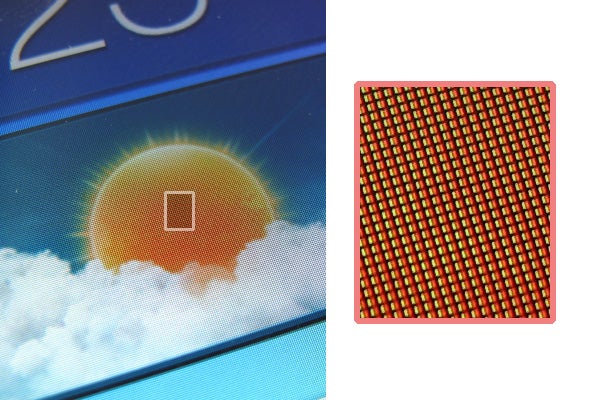
Workman-like rather than wonderful – it’s not bad but this is no “Retina Display”
The device’s problem is that some phones available for less – such as the Orange Monte Carlo – offer similar image quality or less money. Along with the ability to phone people, of course.
Software
At present, the Samsung Galaxy S WiFi 4.2 runs Android 2.3 Gingerbread. This is not the latest version of Google’s OS – version 4.0 Ice Cream Sandwich is out on the town right now – and although Samsung promises an update, it’s disappointing to see it left out. 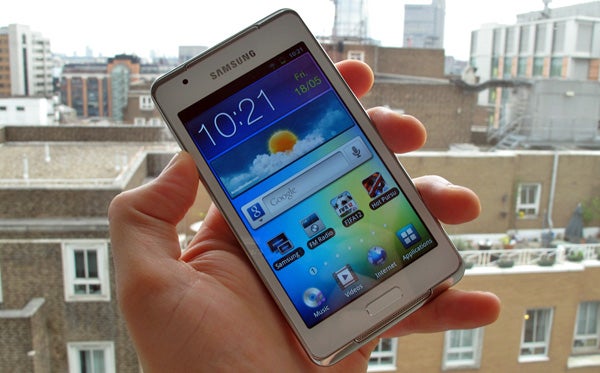
However, Android 2.3 is still a good fit for this kind of device. Just like an Android smartphone, you’re given a brace of home screens you can litter with widgets – seven as standard – and access to more apps than you could ever hope to use.
Unlike some non-phone Android devices, the Galaxy S WiFi 4.2 has full access to the Google Play app store and must-have Google apps like Mail, Maps and Navigation. Using it feels just like a phone – it even indexes your contacts in standard phone-like manner, although tap on a phone number and the WiFi 4.2 does… precisely nothing.
It’s not entirely without calling abilities, though. There’s a microphone built-in and a user-facing camera, letting you chat over Wi-Fi using VoIP apps.
TouchWiz
Like virtually all Samsung Android phones, the Galaxy S WiFi 4.2 uses the TouchWiz interface. This offers a few extra widgets, with which you can customise your home screens, an icon dock at the bottom of these screens and a tweaked apps menu. You can view your installed apps as either a standard four icon-wide grid or a long list.
Samsung apps
The player is also graced with an array of Samsung-made apps. They are – take a deep breath – Smart View, AllShare, Kies Air, Social Hub, Samsung Apps and ChatON.
The only one we’re not too keen on is Samsung Apps. This is Samsung’s own app store, which is a bit redundant when you have Google Play to play with.
Smart View is a DLNA-based app that lets you pipe over what’s on your phone screen to a compatible Samsung TV. The AllShare app is similar, but a bit more involved. Plenty of connected Samsung devices support AllShare, and the app lets you stream videos, photos or music over to them using Wi-Fi. Again, it’s all performed using the DLNA standard. DLNA is notoriously tricky to set up correctly, and these apps make the procedure that bit easier. They are also important because there’s no dedicated physical video output.
Samsung AllShare
Social Hub is probably the most-used of the Samsung apps. This lets you login to social networks Facebook, Twitter and MySpace, and acts as a – you guessed it – hub for all your social networking updates. However, it’s pretty basic and with no social widget available, you’re generally better off with a third-party (or an official) app.
Kies Air is wireless sync device that lets you copy files over from your computer over Wi-Fi and ChatON is a chat interface. You need a phone to register for it over SMS – a bit of a blunder in a non-phone – but it’s inoffensive stuff.
Gaming
Samsung also pre-installs eleven games, including favourites like Angry Birds and Plants Vs. Zombies. All apart from Rovio’s casual smash are trials, though, little more than a taster of what’s out there. With a single-core 1GHz processor, there is some lag in more intense 3D games, and some are not supported by the device. There’s no Galaxy on Fire 2 at present, for example. 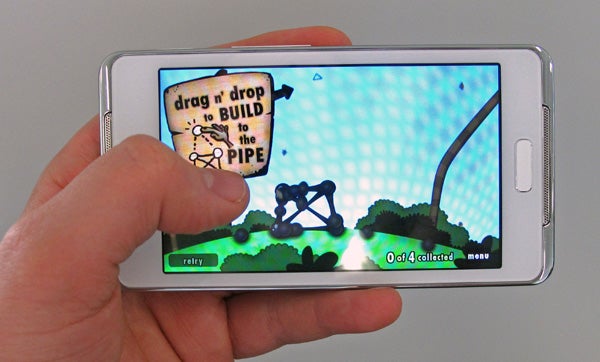
If your main concern is gaming, you’re much better of with an iPod touch. It costs roughly the same amount, and while the extra 0.7in of screen comes in handy here, it’s outweighed by the superior game selection of iOS.
Music
As a device that can’t lean on its phone skills to justify its existence, the Samsung Galaxy S WiFi 4.2 needs to have good media skills. On codec support, it succeeds entirely. On top of the basics like MP3, AAC and WMA, 24bit FLAC and OGG files also work perfectly. Only our 192KHz 24-bit FLAC sample refused to play.
There appears to be a tiny amount of noise when the headphone out is outputting sound, but maximum volume is unusually high. The music player app also incorporates an equaliser and a number of effects.
The scope of these audio enhancements is impressive by phone standards. As usual, the presets are largely horrible, but the user modes give you a decent amount of control. There’s a 7-band EQ, with /- 10dB per band, and a quartet of effects – 3D, bass, Concert (i.e. reverb) and Clarity, a top-end aural exciter. The last in particular is effective with some headphones.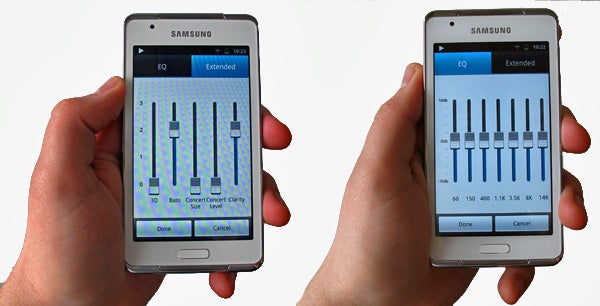
Navigation of the Galaxy S WiFi 4.2 music app is nothing remarkable, though. It makes decent use of album art, but is otherwise a fairly plain affair.
There is also an FM radio. Like almost all portables, it uses the headphone cable as an aerial.
If music-playing is your top reason for buying this device, the lack of physical playback controls are worth noting. Relying on the touchscreen, in-pocket operation is not easy – although there is a finger-friendly volume rocker on its right edge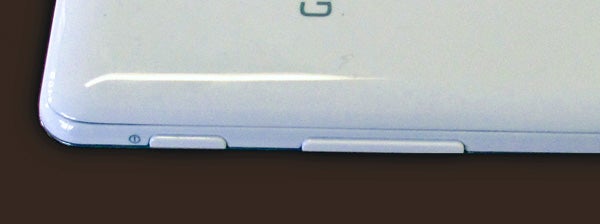 .
.
Video
Impressive file type support continues with video. Almost every common format is supported, including MKV, Xvid and DivX. Again, the video app is nothing special, but it’s the format support that counts.
However, with a single-core 1GHz processor, it can’t handle the breadth of files that – we imagine – the quad-core Samsung Galaxy S3 will. It has a go at playing HD vids, but it struggles to play 720p MKVs, dropping frames to an extent that rules-out watching most HD films on the thing. This is the part of the Samsung Galaxy S WiFi 4.2 that makes us wish it had a dual-core processor, as there’s little lag in day-to-day use.
Camera
Although better-specced than the terrible main camera of the iPod touch, the 2-megapixel sensor of this Samsung Galaxy is not good. It has a fixed focus, meaning you have no control over the subject of your photos. Anything too close-up will not be in focus. There’s also no flash.

The camera app doesn’t offer anything as special as the real-time effects of the Samsung Galaxy Nexus, either. You have a few scene modes as your disposal, as well as exposure compensation, a panorama mode and Smile Shot, which takes a photo when it registers a smile. Some smartphones can replace a compact camera, but with no fun effects to play with and pretty ropey image quality, the Galaxy S WiFi 4.2 cannot. There’s also a basic VGA front camera to enable video chat.
Value
Priced at around £180, the Galaxy WiFi 4.2 is a little more expensive than the 8GB iPod touch. Do the extra screen inches merit this extra? Not really, when the iPod touch features almost double the number of pixels.
However, what’s arguably more a rival to the player is a budget Android phone. Stray from the big brands and you can get a lot for your money, with the £129.99 ZTE Skate or the dirty cheap (but admittedly smaller) £69.99 Huawei Blaze. Shop around and you’ll even find the Samsung Galaxy Ace at a similar price. These phones will have worse speakers and – generally – slightly slower processors, but offer a pretty similar experience, and often better cameras.
This is why an Android player is a tougher sell than an iPod touch. Where its phone equivalent – an iPhone 4/4S – costs between £429 and £699, Androids start at under fifty pounds. There’s a lot of fun to be had with the Samsung Galaxy S WiFi 4.2, but we’re struggling to see where its audience lies. Fans of mobile gaming and video-watching will likely already have a smartphone and, with a single-core processor, so-so screen and poor camera, it’s not really a cheap way to get everything the Samsung Galaxy S3 has for less money. 
It does have far better video and audio support than almost every sub-£200 phone, but when these gaps can often be plugged by apps, we’d recommend looking for a phone. Rather than a phone impersonator.
Verdict
There’s a lot to like about the Samsung Galaxy WiFi 4.2 Android media player. It has better inbuilt speakers than most phones, an attractive design, great audio and video support plus access to plenty of Google goodies. However, these days you can get an Android phone with similar specs for the same money and its video skills are held back a bit by the single-core 1GHz processor.
Trusted Score
Score in detail
-
Design 8
-
Sound Quality 8
-
Features 7
-
Value 7
-
Usability 8
Storage
| Internal Storage (Gigabyte) | 8GB |
| Expandable memory | Yes |
Battery Life
| Video (Hour) | 6hr |
General Features
| Microphone | Yes |
| Speaker | Yes |
| Screen Size (inches) (Inch) | 4.2in |
Audio Codecs
| MP3 | Yes |
| WAV | Yes |
| AAC | Yes |


